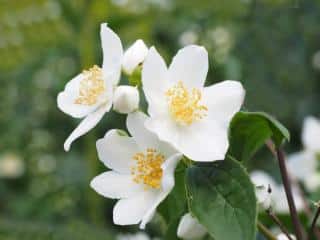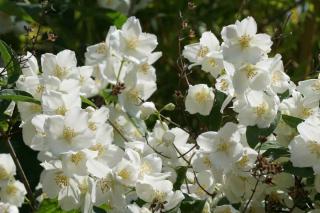

Mock-orange is one of the garden’s most enchanting and fragrant shrubs. Get to know this accommodating, it settles in anywhere it’s planted, and gives the garden a romantic outlook with its cascade of white petals and its scent of fresh orange flowers.
Very easy shrub to live with, mock-orange or Philadelphus produces excellent results in every garden and in every region.
It adapts to any type of soil, even if the result is best when there is a lot of humus.
Sun (but not too hot!) guarantees optimal blooming and beautiful golden hues for the foliage in fall. But even part shade and permanent light shade are not a problem.
All in all, once you’ve caught a whiff of its surprising scent, you won’t want to part with this shrub ever again!
The dormant stage (October to February) is the best time to plant it. That way, it can extend its roots at a leisurely pace and settle in before blooming right in its first year. If you purchase a specimen in a container, wait for its vegetation to slow before transplanting it.
 Let the plant grow wild and free for three years before taming it with its first pruning. This pruning should be performed after the blooming. Shorten the branches that have bloomed by quite a lot, this will stimulate the following year’s blooming, and you’ll be keeping the shrub in tight shape. Mock-orange constantly sends off fresh shoots from its base. You can support these youngsters by eliminating older branches that hinder their growth.
Let the plant grow wild and free for three years before taming it with its first pruning. This pruning should be performed after the blooming. Shorten the branches that have bloomed by quite a lot, this will stimulate the following year’s blooming, and you’ll be keeping the shrub in tight shape. Mock-orange constantly sends off fresh shoots from its base. You can support these youngsters by eliminating older branches that hinder their growth.
No need for any treatment, mock-orange shrubs rarely fall sick to disease. However, add magnesium and potassium-rich fertilizer after the blooming to help prepare new flower buds before fall.
 In a small garden, plant your mock-orange near the house to avail of its delicious fragrance. Pair it with a late-blooming clematis to extend its appeal. If you’re more attracted to its fragrance, choose simple-flower varieties, they release more perfume than double-flowered varieties. For a romantic garden, pair it with fragrant rose trees, foxglove and larkspur. With bamboo and hosta, it will take on a more trendy, modern appeal.
In a small garden, plant your mock-orange near the house to avail of its delicious fragrance. Pair it with a late-blooming clematis to extend its appeal. If you’re more attracted to its fragrance, choose simple-flower varieties, they release more perfume than double-flowered varieties. For a romantic garden, pair it with fragrant rose trees, foxglove and larkspur. With bamboo and hosta, it will take on a more trendy, modern appeal.
As part of a flowered hedge, it can be set next to purple filbert, which complements its color magnificently.
Lastly, for balconies, try to pick smaller varieties. Plant them in a garden box 12 to 16 inches (30 to 40 cm) deep, in a blend that is equal parts rose tree soil mix and light garden soil.
Marie Etavard